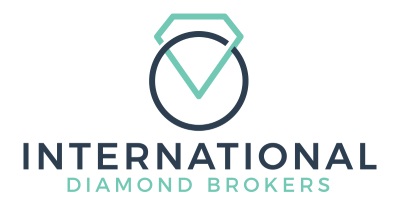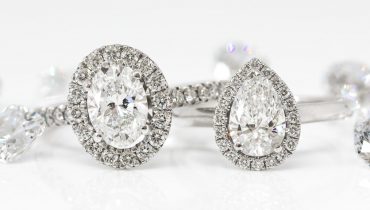The 4 C’s – Buying the best value Diamond
Using Your Knowledge Of The Four C’s And Without Paying A Premium

If you have are about to purchase a diamond then you need to educate yourself to find out are you getting good deal. – many high street jewellers will encourage you to purchase the diamonds that they have in stock as opposed to sourcing a stone to suit your requirements.
Start by understanding what it is you want from a diamond especially when you look at it; do you want the diamond to sparkle, do you want the diamond to be bright and white, or do you want the largest diamond that your budget can buy you? Unless of course you have an unlimited amount of money to spend on a diamond, you will find that at some point you will have to compromise on one of the four C’s.

The 4 C’s
- Colour
- Clarity
- Cut
- Carat
The Colour
Or rather – the lack of colour!
When buying a diamond, with the exception of purchasing a fancy diamond, you want your diamond to be as free from colour as possible. The diamond colour grading system begins alphabetically from D and goes right the way through to Z
The colour is an important visual characteristic, the higher the colour grade, the brighter and “whiter” the stone appears. The GIA (Gemological Institute of America) are a diamond certification body and use sub-groupings to further simplify the colour grading system:
- Colourless are grades D-F
- Near Colourless are grades G-J
- Faint Yellow are grades K-M
- Very Light Yellow are grades N-R
- Light Yellow are grades S-Z
What colour grade should you look for when buying a diamond?

A diamond which is a colour grade D is deemed as the best and most rare, therefore you pay a premium for a stone of this colour grade. Unless you have a highly trained eye, and have two loose diamonds sitting next to each other on a plain piece of white paper, at least 3 colour grades apart – it is very difficult to see the subtle colour difference. However is can greatly affect the price of a diamond.
Our recommendation would to be to stay in the “near colourless” grades and the “colourless” range, preferably grades G colour and above. Diamonds in the near colourless range will be sensational and bright but without the high price tag. It is not a necessity to have a D coloured diamond, especially when even one colour grade down will look almost identical but may save you a lot of money.
The Clarity
Diamonds are created deep within the earth’s mantle in extreme conditions. The environments in which they develop in are far from controlled and so inclusions and blemishes can form and are present in almost all diamonds. Flawless diamonds are exceptionally rare thus there is a premium should you wish to acquire such a stone. Some jewellers may have a negative view on inclusions and blemishes, but ultimately they are after all, natures hallmark and fingerprint.
The grades for clarity are similar across many certification bodies, with slight variations. The grades are based upon how free from inclusions and blemishes a diamond is using 10X magnification. The clarity is graded with a number of factors in mind such as placement, the size of the inclusion, the number of inclusions, the colour of the inclusion as well as a whole range of other factors.

The clarity grades from the IGI (International Gemological Insitute):
- Flawless – F
- Internally Flawless – IF
- Very Very Slightly Included 1 & 2 – VVS1 & VVS2
- Very Slightly Included 1 & 2 – VS1 & VS2
- Slightly Included 1 & 2 – SI1 & SI2
- Imperfect 1, 2 & 3 – I1, I2 & I3
It is advisable to stay above the imperfect range unless it is a specific look that you are going for, as the more heavily included your diamond is, the less valuable it is – so keep this in mind when purchasing your stone.
Slightly Included diamonds are our personal favourite as you can absolutely have a stunning slightly included diamond which is perfectly eye clean and does not impact on your diamonds fire or brilliance. An eye clean stone is a stone which has no visible inclusions, especially in the top table facet, from a distance of circa 6 – 8 inches away from an unaided eye.

If you wish you to have a higher clarity diamond, it will cost extra and it is not a necessity, as all you need a diamond to be is eye clean. Otherwise you are paying a premium for a characteristic you cannot physically see without the aid of 10X magnification and a trained eye.
The Cut
Would you like your diamond to sparkle – should have been the title here! A diamond is known for its brilliance, fire and scintillation, which are a direct result of how well it has been cut and how good the proportions, symmetry and polish are. The cut grades are a measure of how well a diamond interacts with light and the light return that it gives.

The cut grades from the IGI are:
- Excellent
- Very Good
- Good
- Fair
- Poor
You do not, under any circumstances, wish to purchase a poor or a fair cut diamond. This will simply be a diamond which is either cut too deep or too shallow, which results in light leaking out of the sides and will be a lifeless diamond. It would be like a person without a personality – the sparkle is the epitome of a diamond.
The cut does not refer to the shape of the diamond, however the shape and cutting style plays a role in the overall cut grade. The most popular shape of a diamond is a round diamond, but a diamond can be cut in numerous different shapes including an oval, a marquise or even a heart shape!
The perfect cut arrangement originated in 1919 by Marcel Tolkowsky. He calculated the specifics to achieve a perfect cut diamond, the optimum number or facets, their perfect placements, along with the exact and best proportions to provide the maximum light return and dispersion. This cut is one of the most famous diamond cutting styles, known all over the world and is still used to this day – the round brilliant cut. Other cutting styles include the step cut and mixed cuts.
The Carat
The carat is the measurement of the weight of a diamond. The carat weight is a metric measurement divided into 100 points – the precise weight of a 1 carat diamond is 200 milligrams. To some, a diamonds carat weight can be one of their main priorities. However, if you have a very strict budget this could mean that you are compromising too heavily on another characteristic in order to achieve the biggest diamond for your price range.
You can be clever when it comes to choosing the size of your diamond. For example, if you are interested in a 1 carat diamond and you include in your search a diamond between the ranges of 0.90ct – 0.99ct, it can look very similar in size to a 1 carat diamond and may even spread the same. By lowering your carat weight search, you could find the perfect diamond of a similar size, yet save yourself a lot of money. The spread of a diamond is a measurement in millimetres – an average 1 carat measures around 6.4mm.
Avoid, where possible, benchmark carat weights such as 0.50ct, 0.75 and the definitive 1 carat mark. Diamonds are sold on price per carat basis, and a typical consumer wishes to be able to say that she has a 1 carat diamond solitaire engagement ring, therefore a 1 carat stone costs a premium. Unfortunately there is no steady correlation between the price of a diamond and its carat weight. Discuss with your local jeweller as to what carat you are aiming for and what could look like a similar sized diamond, but without the premium price.
The 5th C?
The Certificate of Course!
Which diamond certificate should you look for?

The GIA are undoubtedly the most globally recognised diamond graders and have a fantastic reputation; however there are other highly reputable and well known certification bodies such as HRD (Diamond High Council) and the IGI (International Gemmological Institute). The IGI were established in 1975 and have worldwide laboratories including the oldest laboratory in Antwerp, and the HRD were established in 1973 and pride themselves on integrity and developing new ways to screen and examine diamonds.

Despite how they may seem, diamond certificates are actually not hard written scientific facts but are ultimately an opinion from trained diamond graders. I would advise looking at all reputable diamond certifications with your diamond as this could also save you money when purchasing a loose diamond or an engagement ring. GIA certified diamonds due to a number of reasons, but mostly down to incredible marketing, demand higher prices than the exact same diamond but with an alternative certification.
A standard HRD certificate includes the following information:
- The date of the diamond report
- Report number – referring to the laboratories database
- Shape of the diamond
- Measurements of the diamond in millimetres
- The carat weight, the colour grade, the clarity grade and the cut grade – the important four C’s!
- The finish, polish and symmetry of the diamond
- The fluorescence of the diamond
- An inclusion plotting diagram – typically only present if a diamond is over 1 carat
- HRD cut, colour and clarity grading scales
Fluorescence

A natural phenomenon is diamond fluorescence which refers to when a diamond emits a glow, typically a blue glow, when under an ultraviolet source such as a black light or strong sunlight. Not all diamonds have fluorescence, only around 25 – 35% of diamonds show a degree of fluorescence. When looking for your perfect diamond we advise to look for diamonds which have none, faint or slight fluorescence. Strong fluorescence can have a negative visual impact on the diamond by making it appear milky or cloudy to the naked eye.
Ask Your Local Jeweller
If you are in the midst of looking for a loose diamond or a diamond engagement ring, you should ask your local jeweller questions on anything you do not understand about the four C’s. Do not be pressured into buying a diamond you do not wish to own, even if you think it is a bargain – it could be a bargain for the wrong reasons.
We Can Help You Too!
We have access to over 1 million diamonds, and so if you would like to discuss purchasing a loose diamond from us, or you are interested in creating a bespoke diamond engagement ring – we can help!

Please do not hesitate to contact us via email contact@internationaldiamond-brokers.com.
To see or follow our work, please visit our Facebook page or find us on Instagram.
We can create you the perfect diamond engagement ring and tailor it specifically to your personal preferences and your price range. We can take your dream and make it a reality.






